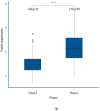Protein Requirement Changes According to the Treatment Application in Neurocritical Patients
- PMID: 37984964
- PMCID: PMC11220411
- DOI: 10.3340/jkns.2023.0176
Protein Requirement Changes According to the Treatment Application in Neurocritical Patients
Abstract
Objective: Exploring protein requirements for critically ill patients has become prominent. On the other hand, considering the significant impact of coma therapy and targeted temperature management (TTM) on the brain as well as systemic metabolisms, protein requirements may plausibly be changed by treatment application. However, there is currently no research on protein requirements following the application of these treatments. Therefore, the aim of this study is to elucidate changes in patients' protein requirements during the application of TTM and coma therapy.
Methods: This study is a retrospective analysis of prospectively collected data from March 2019 to May 2022. Among the patients admitted to the intensive care unit, those receiving coma therapy and TTM were included. The patient's treatment period was divided into two phases (phase 1, application and maintenance of coma therapy and TTM; phase 2, tapering and cessation of treatment). In assessing protein requirements, the urine urea nitrogen (UUN) method was employed to estimate the nitrogen balance, offering insight into protein utilization within the body. The patient's protein requirement for each phase was defined as the amount of protein required to achieve a nitrogen balance within ±5, based on the 24-hour collection of UUN. Changes in protein requirements between phases were analyzed.
Results: Out of 195 patients, 107 patients with a total of 214 UUN values were included. The mean protein requirement for the entire treatment period was 1.84±0.62 g/kg/day, which is higher than the generally recommended protein supply of 1.2 g/kg/day. As the treatment was tapered, there was a statistically significant increase in the protein requirement from 1.49±0.42 to 2.18±0.60 in phase 2 (p<0.001).
Conclusion: Our study revealed a total average protein requirement of 1.84±0.62 g during the treatment period, which falls within the upper range of the preexisting guidelines. Nevertheless, a notable deviation emerged when analyzing the treatment application period separately. Hence, it is recommended to incorporate considerations for the type and timing of treatment, extending beyond the current guideline, which solely accounts for the severity by disease.
Keywords: Neurocritical care; Nitrogen balance; Nutrition support; Protein requirement; Urine urea nitrogen.
Conflict of interest statement
No potential conflicts of interest relevant to this study exist.
Figures



Similar articles
-
Comparison of urine urea nitrogen collection times in critically ill patients.Nutr Clin Pract. 2005 Apr;20(2):271-5. doi: 10.1177/0115426505020002271. Nutr Clin Pract. 2005. PMID: 16207662
-
Accuracy of two-hour urine urea nitrogen determinations in critically ill patients.Clin Pharm. 1984 Jul-Aug;3(4):408-11. Clin Pharm. 1984. PMID: 6432421
-
Predicting total urinary nitrogen excretion from urinary urea nitrogen excretion in multiple-trauma patients receiving specialized nutritional support.Nutrition. 2005 Mar;21(3):332-8. doi: 10.1016/j.nut.2004.07.005. Nutrition. 2005. PMID: 15797675
-
A simple method for estimating nitrogen balance in hospitalized patients: a review and supporting data for a previously proposed technique.J Am Coll Nutr. 1985;4(5):575-81. doi: 10.1080/07315724.1985.10720100. J Am Coll Nutr. 1985. PMID: 3932497 Review.
-
Protein requirements of infants and children.Nestle Nutr Workshop Ser Pediatr Program. 2006;58:39-47; discussion 47- 50. doi: 10.1159/000095009. Nestle Nutr Workshop Ser Pediatr Program. 2006. PMID: 16902324 Review.
Cited by
-
Early Adequate Nutrition in ICU Is Associated with Survival Gain : Retrospective Cohort Study in Patient with Traumatic Brain Injury.J Korean Neurosurg Soc. 2025 Mar;68(2):177-183. doi: 10.3340/jkns.2024.0157. Epub 2024 Nov 8. J Korean Neurosurg Soc. 2025. PMID: 39511706 Free PMC article.
References
-
- Ashcraft CM, Frankenfield DC. Energy expenditure during barbiturate coma. Nutr Clin Pract. 2013;28:603–608. - PubMed
-
- Bidkar PU. Nutrition in neuro-intensive care and outcomes. J Neuroanaesth Crit Care. 2016;3:S70–S76.
-
- Bingham SA. Urine nitrogen as a biomarker for the validation of dietary protein intake. J Nutr 133 Suppl. 2003;3:921S–924S. - PubMed
LinkOut - more resources
Full Text Sources
Research Materials

